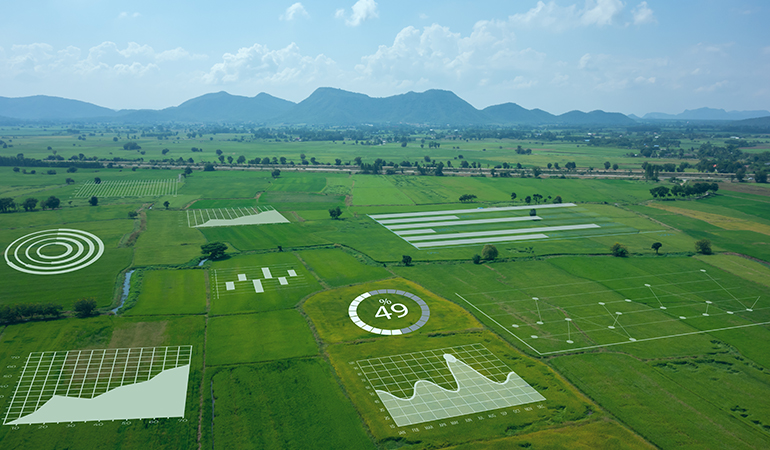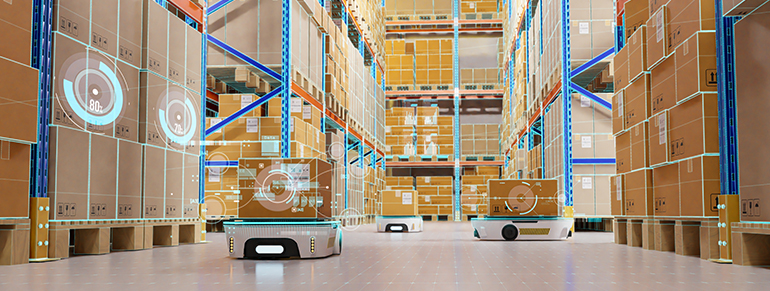Productivity has always been a major economic driver, leading businesses to invent bold new ways of increasing it. Calculated by a simple formula, productivity is the value of goods produced within a unit of time. Naturally, businesses strive to maximize this value because it has a direct impact on their revenue.
From elementary math, we know that to increase the quotient (labor productivity), we need to increase the dividend (value of goods) and/or decrease the divisor (input man hour). AI-powered automation can do both, improving overall business productivity.
From our experience developing artificial intelligence (AI) and machine learning (ML) solutions for businesses in various industries, we can vouch for the superb ability of AI and ML to accelerate processes and boost production quality. With speed and quality being essential to productivity, let’s dive deep into how AI-based automation helps companies become more productive.
Understanding AI automation
In general, automation describes any technology that reduces or replaces human intervention in any work process. AI-powered automation is just one aspect of business process automation. Artificial intelligence, including machine learning, deep learning, and natural language processing, automates data analysis by processing both structured and unstructured data in large volumes and generates insights used in decision-making.
It is important to note that AI and automation are not the same. Artificial intelligence complements other technologies used to automate business processes, powering intelligent automation solutions capable of running entire workflows with minimum human interference:
- Robotic process automation (RPA) performs basic routine tasks.
- Business process automation enables automated workflows and integrations between system components forming comprehensive platforms.
- AI, ML, computer vision, and other data processing technologies are responsible for cognitive decision-making.

How AI-based automation transforms businesses
In the context of raising business productivity, AI-driven automation solutions can make a substantial difference. Coming back to the productivity formula above, we can say that all the advantages artificial intelligence brings to a business serve the two main productivity-boosting factors: increasing the value and reducing the resources required.
A study by PWC shows that increased labor productivity is the greatest value gain achievable from implementing AI. On a global scale, labor gains may be the most significant component of GDP growth.
Global impact of AI on GDP

Source: PWC
Increased efficiency
Artificial intelligence can take over many mundane tasks, accelerating their completion and freeing the human workforce for more complex activities. With AI, lots of processes can be executed in less time and with fewer resources:
- Process optimization. AI-powered analysis of related datasets and identification of bottlenecks allows companies to re-evaluate resource allocation and implement more efficient process configurations.
- Real-time decision-making. Leveraging AI’s advanced data processing capabilities to dynamically generate insights from incoming data, businesses can more effectively use emerging opportunities and respond to risks.
- Time management and prioritization. Analyzing routines and focusing on important tasks, artificial intelligence can assist in creating and optimizing business schedules for maximum efficiency.
Improved value
In addition to reducing the time and resources required to produce goods or services, AI can also improve their value, boosting efficiency:
- Higher accuracy. Compared to manual processing, AI can be more accurate and precise in managing both structured and unstructured data relevant to business processes. Besides, AI is not prone to errors that humans can make as a result of tiredness or distraction. The quality of AI-produced data analytics is therefore higher, and such analytics are more trustworthy.
- Security and privacy. With AI-powered security mechanisms, there is a much higher chance of detecting potential threats early. By identifying vulnerabilities and taking timely preventive measures, AI-assisted security solutions safeguard data from being compromised and improve the overall quality of service.
- Support for innovations. By freeing human resources from tedious tasks, AI leaves people with more time to explore and experiment. At the same time, AI can be involved in monitoring user feedback and detecting sentiment in customer reviews, posts, and other online content, detecting issues and suggesting improvements.
Cost savings
AI automation solutions implemented at various stages of business processes have the potential to reduce production and maintenance costs, directly impacting overall productivity:
- Reduction in labor hours. By using artificial intelligence in automation of various tasks, companies can review their employees’ assignments, sometimes even eliminating positions completely. However, currently only a small portion of manual tasks can be cost-efficiently accomplished by automation with AI tools. A 2024 MIT study showed that in some areas, only about 23% of worker tasks can be done by AI without additional costs. More complex tasks require more sophisticated (and more expensive) AI solutions.
They [workers] see it [AI] as something that enables them to be more productive, to remove some of the mundane in their day-to-day work, an opportunity to develop new skills and, ultimately, an opportunity to create new job opportunities.
- Preventive maintenance. When equipment maintenance is automated by AI, deviations from the norm are detected almost immediately, giving maintenance crews enough time to take preventive measures. Proactive maintenance minimizes downtime, increasing equipment productivity and raising ROI.
- Energy efficiency. Artificial intelligence can automate monitoring and management processes in energy networks, responding to changes in environmental conditions and usage patterns by dynamically adjusting lights, heating, ventilation, and air conditioning. This optimizes energy consumption, lowering costs for the business.
How AI automation is used in industries
While AI-powered automation offers common benefits for multiple industries, some enterprises find non-standard ways of leveraging this technology to increase productivity.
Healthcare
The healthcare industry is adopting AI at an increasing pace, harnessing the outstanding data processing capabilities that the technology offers. From carrying out administrative tasks to structuring research data and powering medical assistance chatbots, artificial intelligence brings speed and precision to multiple processes in healthcare institutions.
An interesting use case of AI in healthcare is a suite of specialized AI imaging applications by Merative. Designed for certain areas of medicine, Merative solutions take advantage of AI to read and interpret images and create reports, reducing the time doctors need to spend on diagnosis and confirming their findings with precise information.
Agriculture
Even in such a nature-dependent area as agriculture, AI has found multiple uses. Farming is getting increasingly smarter with IoT devices monitoring the state of soil and crops as well as weather conditions. On the other hand, farmers rely on a growing volume of historical and statistical data to plan their activities and predict trends. Here, AI can be indispensable, with its ability to analyze data and isolate patterns.
John Deere, a leader in the agricultural equipment and technology industry, has found an unusual application for artificial intelligence in its See & Spray™ Ultimate sprayer. The equipment uses computer vision and machine learning to distinguish between crops and weeds and only target weeds with herbicides. The company claims that the technology reduces the amount of herbicide used by more than two-thirds.

Manufacturing
In the manufacturing industry, AI-powered automation enhances and accelerates multiple processes, from supply chain management to predictive maintenance and documentation handling. Intelligent tools can monitor equipment statuses, maintain inventory, generate reports, and optimize resource allocation.
One pioneering application of artificial intelligence in manufacturing is quality control, where AI tools help to ensure production quality and detect issues. This is the approach BMW took in its BMW iFACTORY initiative pairing AI with IoT to raise the quality of produced vehicles and thus improve efficiency of the production process.
On the BMW iFACTORY assembly line, cars become participants in production processes, checking connections with built-in sensors and reporting any deviations. Automated quality inspection is also performed by multiple cameras installed along the assembly line, coupled with AI algorithms that analyze visual data.
Finance and investments
Recognizing the power of AI analytics, banking, financial, and investment companies are adopting artificial intelligence solutions to automate routine processes and boost productivity. From algorithmic trading and predictive analytics to customer service chatbots and reporting, applications of AI in the financial industry are multiple and diverse.
A prominent example of using AI to transform investment flows is the Kensho branch of S&P Global. Kensho presents a line of AI-driven financial solutions processing large volumes of various types of data to generate investment insights both for the bank and its external clients. Kensho tools use natural language processing to ingest text documents, smart search to enable data extraction, and self-learning capabilities of AI to support broad customization.
Artificial intelligence is not a substitute for human intelligence; it is a tool to amplify human creativity and ingenuity.
Examples of using AI-driven automation to increase productivity
As artificial intelligence evolves and its analytical capabilities develop, applications abound in multiple industries. As a breakthrough technology capable of transforming business flows, AI finds uses in hundreds of processes in virtually every industry. Intelligent tools prepare documents, maintain schedules, monitor equipment, and support analytical tasks. We will surely see more of this pioneering approach soon enough, but let’s take a look at some real-life AI automation examples.
ML-enabled mammography platform
Digital radiography and mammography are widely used in today’s diagnostics; however, the healthcare industry continues to look for advanced technologies to enhance the capabilities of this methodology for early anomaly detection.
A leading provider of RIS, PACS, and digital radiography solutions has implemented a machine learning algorithm to achieve precision in breast positioning for cancer diagnostics. This method helps to obtain the most accurate images, allowing doctors to find abnormalities. Image interpretation is enhanced with another AI algorithm that automatically detects anomalies in scans.
In this case, intelligent automation in a healthcare process helps to improve the quality of diagnostics and raises the chance of early cancer detection, improving treatment outcomes.
AI-powered financial trading
A German provider of digital-only banking and financial services uses artificial intelligence in a custom trading platform, aggregating large volumes of data coming from multiple sources and generating actionable insights. Being able to process financial data quickly and precisely, AI algorithms can generate much more accurate predictions than human traders.
The use of AI in financial trading raises the quality of investment recommendations, contributing to positive customer experiences and greater trust in financial businesses. Artificial intelligence applied to massive amounts of financial data can detect trends that may escape the eye of human analysts and result in missed opportunities. With AI on board, traders are much better equipped to make validated decisions.
Automated order management for a logistics company
In a supply and logistics business, a lot of management and administrative work is necessary to keep track of orders placed by customers and processed by the company. As the business grows, the amount of paperwork increases accordingly, requiring more labor hours and increasing the company’s costs.
With order management performed by an AI-powered solution, the speed and accuracy of order processing can be considerably improved, while the time and resources of the sales team can be directed at more complex tasks, such as attracting new customers and engaging existing customers.

Best practices of implementing AI-powered automation
The clear benefits of AI for automation of various processes attract the attention of businesses in multiple industries. To make the most of an AI tool, we recommend the following practices:
- Identify the processes to be automated. As a productivity-boosting tool, AI shines best when applied to repetitive and time-consuming tasks that require little skill, where the cost-to-value ratio is the most beneficial. At the same time, look for data-heavy processes, as AI learns from incoming data.
- Select tools and technologies. Even within a single industry, you may face a wide selection of AI automation software. To choose the right one, consider such factors as the learning curve, integrations with legacy systems, customization, scalability, and support by the provider or developer. A recommended option is to consult with a professional artificial intelligence and machine learning development company to find the solution that best fits your needs.
- Prepare training data. For AI to show its true value, it needs to be trained on relevant and accurate data sets that represent the tasks to be automated. Prepare complete, secure, and compliant data to train your AI models.
- Ensure adoption. Before launching an AI automation project, inform and train the team expected to work with the AI solution. At the same time, communicate the AI automation implementation initiative to major stakeholders and decision-makers.
- Monitor performance. Define key performance indicators and track the effectiveness of the AI automation tool on a regular basis. Pinpoint issues, identify areas for improvement and take the necessary steps: retrain the AI models, try different approaches to using AI-generated insights, or even evaluate other tools.
Overcoming challenges in adopting AI automation
As exciting as the idea of implementing AI automation may be, it comes with a number of challenges that may affect the solution’s performance. However, if you invest time and resources in careful preparation for AI adoption, most of these challenges can be avoided.
- Availability of suitable data. Not all data can be fed to artificial intelligence tools as is; most needs to be cleaned and prepared for consumption by AI models. Data preparation is a high-skill job done by data scientists, so you need to either have one on board or engage the services of a data engineer from an artificial intelligence services company.
- Incorrect evaluation of tasks to automate. At the early stages of adoption of AI in automation of business flows, it may be tempting to use AI for as many processes as possible. At the same time, some activities still need a human presence, such as in customer service and healthcare. AI can do its part, but at certain points, a human needs to step in and take over.
- Bias. If the AI model was trained on an inherently biased dataset, it will generate equally biased results. To prevent this, it is essential to check the results produced by AI to verify the absence of bias and, if necessary, to adjust data sets and retrain the model.
- Skill gap. Artificial intelligence is a complex technology requiring special knowledge and experience to manage. When preparing to implement an AI solution, make sure to provide training for employees who are expected to work with AI tools.
- Data security. When training an AI model, make sure to prevent sensitive data from being compromised if using public artificial intelligence tools, such as ChatGPT. If your line of business involves managing personal data or intellectual property, a better solution is to build an internal AI model and train it in-house.
- Regulatory compliance. As AI automation is still an emerging technology, its use is not yet universally regulated. However, there are growing concerns about copyright infringement by AI tools and the use of intelligent tools in critical industries. At the moment, governments are discussing laws regulating and restricting the use of AI in certain areas. For example, the European Union is in the process of adopting the EU Artificial Intelligence Act, designed to classify areas of AI application and restrict its use in those considered high-risk.
Before implementing AI automation in your business, we recommend that you check the current state of laws and regulations related to the use of AI, especially if you are planning to use a publicly available AI solution.
Are you ready to let AI automation in your business environment?
Artificial intelligence is here, and it is here to stay. With all the concerns it might raise, its benefits cannot be denied. When used to complement human intelligence in a supervised environment, AI can make a notable difference in business productivity and performance.
Effective use of artificial intelligence and automation tools requires a certain technological maturity in terms of skills, knowledge, and experience. However, don’t let it discourage you on your path to AI-assisted transformation and discovery of the wide range of its benefits. Contact Intellias and we will gladly support you in adopting artificial intelligence and other technologies and share our expertise in making them work for your success, growth, and competitive advantage.



